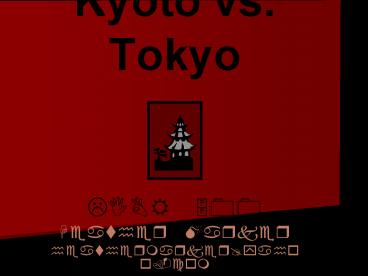Kyoto vs. Tokyo PowerPoint PPT Presentation
1 / 15
Title: Kyoto vs. Tokyo
1
Kyoto vs. Tokyo
- LIBR 500
- Heather Marker
- heathermarker_at_yahoo.com
2
Kyoto vs. Tokyo
- A brief account of my trip to two spectacular
Japanese cities. To my uninitiated western eye,
these two cities seemed worlds apart. A
comparison of Kyoto and Tokyo, based on my
impressions, is the theme of this presentation.
I hope youll enjoy.
3
First, a few facts to orient you
- Kyoto
- Its name means capital
- Is a tourist mecca famous for its historical
treasures - Was home to the emperor and capital city from 794
to 1603 - Has a population of 1.5 million, making it
Japans 5th largest city
- Tokyo
- Its name means eastern capital
- Is famous for being (arguably) the most expensive
city in the world - Became the capital city in 1603
- Has a population of 10 million in central Tokyo
the greater metropolitan area has a population of
approx. 30 million
4
An example of Kyoto architecture
- The architecture of Kyoto reflects its long
- history as the capital city. The city boasts
- some
- 1,600 Buddhist temples
- 400 Shinto shrines
- As well as
- 2 imperial villas
- 1 palace
- 1 castle
- Pictured at right is Sanjunoto (Three
- storied pagoda) at the Kiyomizudera
- Temple grounds.
5
Examples of Tokyo architecture
Architecture in Tokyo is modern, but no less
awe-inspiring!
6
The Pace of life in Kyoto
- During Kyotos winters, when tourists become
scarce, one can experience the sites in their
quiet beauty as intended. A little serenity is
required if you hope to achieve a Zen state at
the famous rock garden at Ryoanji Temple.
7
But Tokyos bustle knows no season
- The streets are packed and often frantic, but
always polite. In this urban jungle, refreshment
for the fatigued trekker is never far away. - Just look for one of the ubiquitous vending
machines. They can and do vend almost anything
of appropriate dimensions, but most commonly
offer sustenance for the weary, like coffee, tea,
and energy drinks, as well as warm soup, snacks,
and beer.
8
A symbol of wealth in Kyoto
- Kyotos three leveled Kinkakuji Templeor Golden
Pavilionis a symbol of national wealth. - Although only a replica of the original, which
was built in 1397 and burned down in 1950, the
gold leaf is real.
9
A symbol of wealth in Tokyo
- This three story home in suburban Tokyo is
symbol of personal wealth. - A mansion by Tokyo standards, the structure
occupies the entirety of the plot. There may be
no yard, but there is a garden off the second
floor balcony.
10
Speaking of wealthA Saturday in Tokyo SHOPPING
- Tokyo-ites really like to shop! Some popular
districts for shopping are - Ginza
- for everything high-end
- Harajuku
- for everything cute and kitschy
- Shibuya
- for everything trendy
- Akihabara
- for everything electronic
(Shibuya on a Saturday afternoon)
11
My pick for the best of Kyoto
- A visit to Sanjusangendo
- The temple houses 1001 statues, carved in the
12th and 13th centuries, of Kannon, the Buddhist
deity of compassion. - The face and details of each statue are unique.
According to tradition, the Japanese make an
offering to the statue whose face most resembles
their own or the face of the one for whom they
pray. - Want to find your likeness? Try this link to an
extensive photo gallery of the statues at
Sanjusangendo
http//rubens.anu.edu.au/new/japan/kyoto/sanjusan
gendo/
Photo source The National Treasure Sanjusangendo
visitor guide.
12
My pick for the best of Tokyo
- People-watching, of course!
- Ultra-stylish, busy, and crowed, Tokyos streets
are never, ever boring. And while Japan may have
one of the most homogeneous societies in the
world, its citizensespecially its youthtake the
expression of individuality to extremes.
13
But, to be fair
- My impressions make for a superficial
comparison, and hardly do justice to either of
these incredible and complex cities. - Kyoto is of course a truly modern city. With a
population of 1.5 million, it is major commercial
and urban centeras busy as any of similar size. - And of course Tokyos not all concrete, crowds,
and neon lights. With 400 years as the capital
city, evidence of Tokyos history is plentiful,
and you can even find some peace and quiet in the
heart of the cityfor example, in the garden of
the Imperial Palace, pictured here.
14
THE END
15
- Resources
- All photos used in this presentation are my own,
with the exception of the photo of Sanjusangendo,
which was taken from the National Treasure
Sanjusangendo visitor guide. No details of
publication or ownership have been included in
the guide. - Statistical figures taken from Insight Guide
Japan, ed. Scott Rutherford, Apa Publications,
2002. - Thanks to Christopher Thompson for creating the
animated fish and rising sun!
THE END

